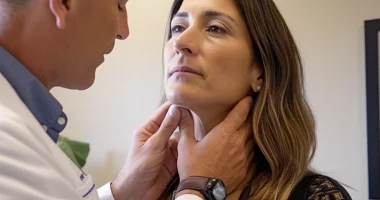Biceps tendinopathy
General information
Tendonitis of the biceps tendon (biceps muscle) is a painful condition accompanied by inflammation of the upper part (segment) of the tendon of the long head of this muscle, connecting its abdomen with the bones in the shoulder joint area.
Biceps tendonitis, is inflammation in the main part of the tendon that attaches the tip of the biceps muscle to the shoulder. The most common cause is overexertion from certain jobs or sports. However, biceps tendonitis can also develop gradually due to natural wear and tear or direct trauma. Inflammation of the tendon can also occur due to other injuries in the shoulder, such as rotator cuff injury, impingement, or instability.
Anatomical features of the shoulder joint:
The shoulder joint has a spherical shape and is formed by the clavicle, humerus, and scapula. In addition, other anatomical structures are involved in the formation of the shoulder joint:
- Glenoid is a scapular socket surrounded by cartilage that connects to the head of the humerus. This type of cartilage formation provides optimal articulation with the head by increasing the area of the socket;
- Rotator cuff – a set of tendons and muscle tissues that fix the humeral head at the same level as the glenoid;
- Biceps (double-headed muscle): This muscle consists of 2 tendons located on the anterior humeral surface and connected to the bones in the shoulder area.
What is biceps tendinopathy?
As mentioned above, biceps tendinopathy is an inflammatory process affecting the tendon of its long head. At the initial stage of manifestation of the disease, swelling and hyperemia may be observed, and as it develops, tissue thickening may occur.
As a rule, with the subsequent progression of tendonitis, the tendon may acquire a dark red color and its structure, which often leads to tissue separation (rupture); the development of tendonitis is paired with other types of ailments occurring in the shoulder joint:
- Rotator cuff injury;
- Impingement and osteoarthritis of the shoulder joint;
- Habitual dislocation;
- Rupture of the articular labrum, etc.
The main causes of tendinopathy
Often, the initial causes of biceps tendon injury are both everyday physical activity and more intense loads, for example, when practicing sports. The fact is that with age, human anatomical structures wear out and lose their former elasticity and strength. At the same time, degenerative changes occurring in the tissues, over time, make themselves known, including when performing the most common movements.
Prolonged or repetitive movements in the shoulder can put excessive strain on the biceps tendon. In such cases, the tendon tissue does not have enough time to regenerate, which leads to the development of tendonitis. Most often, biceps tendonitis occurs in certain sports or activities that require repetitive overhead arm movements. In athletes, these are sports such as swimming and tennis. When inflammation occurs due to wear and tear, the tissue shows signs of degeneration. Degeneration in the tendon leads to a disruption in the normal presence of collagen fibers that form the tendon. Some fibers of the tendon become tangled, and others tear due to degenerative processes, and thus, the tendon loses strength. When degenerative processes occur in the biceps tendon, the tendon becomes inflamed, and sometimes, it can rupture.
Biceps tendinitis can also occur from direct trauma, such as a fall on the top of the shoulder. Tears of the transverse ligament of the upper arm can also lead to biceps tendonitis (the transverse ligament of the upper arm holds the biceps tendon in the bicipital notch near the top of the humerus). If this ligament is torn, the biceps tendon is free to pop out of the notch and become irritated, resulting in inflammation of the biceps tendon.
Symptoms of the disease
The main symptoms of tendinopathy include:
- painful sensations in the corresponding area, which significantly increase with increased physical activity or even with normal lifting up of the arm;
- clicks in the shoulder area, etc.
When examining the disease, the treating specialist finds out the patient’s main complaints, as well as assesses muscle tone and volume of movement. In addition to all of the above, the doctor may prescribe special tests.
Diagnosis
To clarify the diagnosis, the specialist may use auxiliary methods, including radiographic methods – MRI, CT, ultrasound.
For example, through a typical radiograph, the doctor can visually assess the condition of bone structures and, in some cases, diagnose the presence of other additional pathologies.
In turn, ultrasound and MRI allow the most accurate assessment of the anatomical features of soft tissues, determining the presence and nature of their pathological disorders.
Treatment of biceps tendinopathy
The treatment of tendonitis is usually carried out in parallel with the treatment of other shoulder joint ailments, and it is performed using two main methods – conservative and surgical.
Conservative treatment
In most cases, management of biceps tendonitis and its sequelae begins with conservative treatment that includes:
- providing as much rest as possible by reducing activities that cause pain and discomfort;
- use of twenty-minute ice compresses to eliminate swelling;
- taking drugs of the non-steroidal group that reduce pain and inflammatory intensity;
- injections of corticosteroid-based medications that also reduce inflammation and pain levels;
- physiotherapy procedures that have a positive effect on the recovery and strengthening of not only the joint but also the surrounding muscle tissues.
Surgical treatment
Surgical methods of treatment, which include various types of surgery, are relevant in the absence of visible results from conservative methods.
In the vast majority of cases, patients are prescribed minimally invasive arthroscopic interventions. The essence of these procedures is the introduction of a microcamera (arthroscope) into the diseased area, which transmits a magnified and detailed image on the monitor, and the specialist performs various manipulations with specialized and small-sized instruments.
Such manipulations may include:
- connection (suture) of the tendon at the place of its attachment to the articular scapula;
- tenodesis, based on excision (removal) of the injured part of the tendon and subsequent fixation of the intact fragment to the upper part of the humerus.
Another minimally invasive surgical technique, tenotomy, which involves completely cutting the tendon away from its junction with the articular scapula, may also be used.
It is important to note that with certain types of arthroscopic interventions, subsequent complications (inflammation, bleeding) are allowed, most of which, fortunately, are completely eliminated.
All these treatment options are available in more than 790 hospitals worldwide (https://doctor.global/results/diseases/biceps-tendinopathy). For example, Arthroscopic biceps tenodesis can be done in 46 clinics across Germany for an approximate price of $7.6 K (https://doctor.global/results/europe/germany/all-cities/all-specializations/procedures/arthroscopic-biceps-tenodesis).
Rehabilitation
Even a successful surgery requires some recovery period to promote better tissue healing.
During rehabilitation, your doctor may recommend:
- the use of locking bandages;
- decreased physical activity;
- performance of a specially selected set of exercises (physiotherapeutic measures), etc.
The result of successful surgical treatment of tendonitis, in the vast majority of cases, is the restoration of the original (full) range of motion in the joint without accompanying pain.


